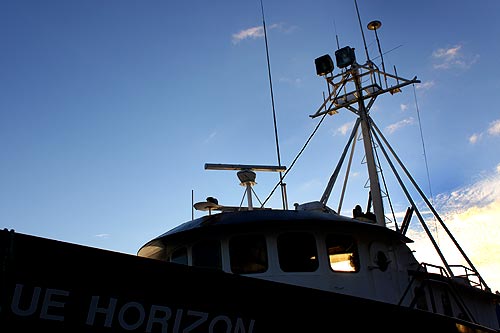Fishing Restrictions for Oregon Coast's Deep Waters Start Friday
Published 07/12/2016 at 5:41 PM PDT - Updated 07/12/2016 at 5:43 PM PDT
By Oregon Coast Beach Connection staff

(Oregon Coast) – Oregon Department of Fish and Wildlife (ODFW) has closed one portion of grounfish angling along the Oregon coast as of this Friday. Fishing outside the 20-fathom line will be closed in order to protect yelloweye rockfish, which are more common in deeper waters.
Populations of yelloweye rockfish along the entire west coast were declared overfished in 2002 by the National Marine Fisheries Service. They are currently managed by the federal government and a rebuilding plan that is hoping to restore populations by various means of protection, including limiting harvests.
Unusually high bycatch rates in the central Oregon coast all-depth halibut fishery and high effort in the bottomfish fishery so far this year have led to increased yelloweye rockfish encounters. In addition, the rate of voluntary descending device use has dropped from 80 percent in recent years to 60 percent in 2016. As a result, estimated mortality from catch-and-release is higher than expected, putting Oregon’s recreational fisheries on track to exceed the 2016 harvest limit before the end of the year.
The fish generally live in much deeper waters, which makes the 20 fathoms dividing line useful: they normally live beyond that barrier. This reduces the catching of yelloweye rockfish, while it allows anglers to continue fishing for popular targets such as black rockfish and lingcod.
Also, fish caught in these shallower waters inside that line are more likely to survive after being released, according to ODFW marine fisheries manager Maggie Sommer.
Due to their endangered status, yelloweye rockfish cannot be retained by anglers and must be released if caught. ODFW encourages marine anglers to release all prohibited rockfish by using a descending device to safely return the fish to depth.
Sommer noted that even fish which appear severely bloated can survive after being released at depth. This practice also helps keep the fisheries open by reducing the percentage of released fish that fishery managers count as dead. The drop in descending device use was likely the tipping point for this decision by ODFW. If the use of the device had remained at 80 percent this year instead of dropping, the projected mortality rates would've remained at an acceptable level and the restrictions would not have occurred.
 Using a descending device helps save fish and increases anglers’ fishing opportunities.
Using a descending device helps save fish and increases anglers’ fishing opportunities.
“This is another way that anglers can help us to recover the yelloweye population and keep these fisheries open,” said Sommer.
She noted that there are several types of descending devices that can be purchased at tackle shops. ODFW has distributed some of the devices provided by the Pacific States Marine Fisheries Commission free of charge to help encourage their use, and has a limited number more to hand out on the summer all-depth halibut days, when many anglers likely to encounter yelloweye rockfish in deeper waters are concentrated at boat ramps and marinas.
“We hope that by limiting the fishery to inside the 20-fathom line we can keep anglers fishing this year by keeping them out of areas where yelloweye are most common,” said Sommer. “Our goal is to return the sport groundfish fishery to all-depth in October as originally planned if at all possible. Increasing use of descending devices can help us get there.”
At this time, the 20-fathom restriction is in place through the end of 2016 until further notice.
The central Oregon coast nearshore and summer all-depth halibut fisheries will remain unchanged. Halibut seasons are set by the International Pacific Halibut Commission and the National Marine Fisheries Service, and cannot be changed in-season due to bycatch concerns under current federal rules. In public meetings on the 2017 halibut and sport groundfish fisheries to be held later this summer, ODFW will be seeking input on modifying the Pacific Halibut Catch Sharing Plan to allowing for in-season changes in the future.
Waypoints for the 20-fathom line may be found on the ODFW website at www.dfw.state.or.us/MRP/regulations/sport_fishing. Oregon Coast Hotels in these areas - Where to eat - Maps - Virtual Tours



More About Oregon Coast hotels, lodging.....
More About Oregon Coast Restaurants, Dining.....
Cannon Beach Lodging
Nehalem Bay Lodgings
Manzanita Hotels, Lodging
Three Capes Lodging
Pacific City Hotels, Lodging
Lincoln City Lodging
Depoe Bay Lodging
Newport Lodging
Waldport Lodging
Yachats Lodging
Oregon Coast Vacation Rentals
Oregon Coast Lodging Specials
LATEST Related Oregon Coast Articles
Likely just before dawn best hour but peak happens during daylight. Weather
Dark Sky Week is Prime Along Oregon Coast: Where and Where Not to Go
General guide to dark sky viewing from south to north coast. Astronomy
Sizable Price Drop, Deals in Lincoln City During Quiet of April on Central Or...
20 perc off at A1 Vacation Rentals across its roster, including Gleneden Beach. Lincoln City specials
Upcoming S. Oregon Coast Events Include Gem Show, History: Coos Bay, Bandon
May 6 talk at Coos History Museum, Mayfly Fest May 17, Bandon Rock / Gem Show June 7,8
Washington Coast Cleanup on April 19 - Coinciding with Oregon Coast's SOLVE E...
From the Puget Sound to Long Beach, alongside Oregon's cleanup. Washington coast events, Seaside events
Astoria's Riverwalk Gets New Lighting, More N. Oregon Coast Roadwork
Delays coming this summer, but the riverwalk has a new look. Seaside, Cannn Beach
April Gets Even Cheaper Midweek at Depoe Bay, Lincoln City: Oregon Coast Deals
Off-season rates plus more at Keystone Vacation Rentals. Depoe Bay lodging specials, Lincoln City hotel reviews, Newport hotel reviews
Washington Coast Begins Week of Clam Digs, April 12 Through 18
Long Beach, Twin Harbors, Mocrocks and Copalis at different times. Washington coast events
Back to Oregon Coast
Contact Advertise on BeachConnection.net
All Content, unless otherwise attributed, copyright BeachConnection.net Unauthorized use or publication is not permitted















































